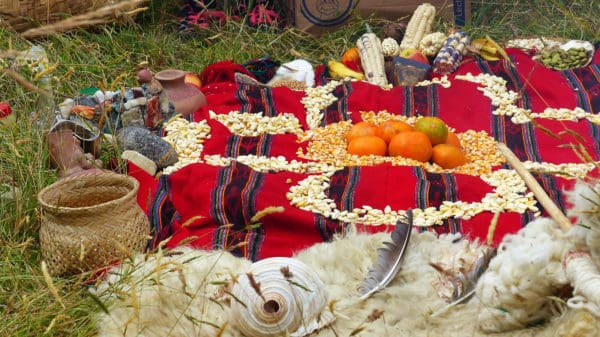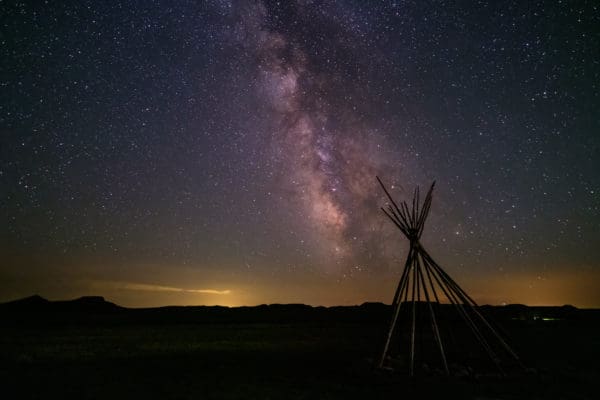Mescaline is a naturally occurring alkaloid found in the peyote and San Pedro cacti of North and South America. The substance is closely intertwined with the history of psychedelics and was one of the main inspirations for psychiatrist Humphry Osmond, who first coined the term psychedelic in 1957. Psychedelic comes from two Greek words, ψυχή (psyche) which means ‘mind or soul’, and δηλοῦν (deloun), which translates as ‘to reveal or make visible’. Together these words are used to mean ‘mind-manifesting’, which is how Osmond described the effects produced by the ingestion of this compound.
The History of Mescaline
As the main psychoactive substance found in the peyote (Lophophora williamsii) or hikuri as it is called by the Wixarika people of Mexico and San Pedro or huachuma (Echinopsis pachanoi) cacti, mescaline has been used by indigenous peoples of North and South America for millennia, consumed during religious, ceremonial, and medicinal practices. The word mescaline has its roots in the Nahuatl word mezcalli which is the term for an intoxicating beverage made from the (unrelated) maguey or agave cactus plant. Peyote and San Pedro are intimately tied to the cultures which use them and are held to be highly significant and sacred components of their cultural cosmologies.
In the late nineteenth century, mescaline became known to a number of individuals in North America and Europe, who began the first scientific explorations of its properties. One of the earliest documented uses of mescaline by a non-indigenous person was the account that writer and physician Havelock Ellis made in his 1898 essay titled Mescal: A New Artificial Paradise. In this essay, Ellis describes some of the details from his knowledge of the ceremonies in which the substance was used as well as his experience after having ingested a concentrate made from three buttons of the peyote cactus. The visions he describes were of objects he characterizes as “extremely definite, but yet always novel; they were constantly approaching, and yet constantly eluding, the semblance of known things.” Ellis recounts that he shared some of the substance he had procured with two well-known poets of his age, one of which is generally regarded to have been his friend W.B. Yeats.
Early Research with Mescaline
Although the chemical compound was first isolated in 1896 and synthesized in 1919, it generally remained outside of public consciousness until the 1950s, when some pioneering scientists began experimenting with the substance. Osmond was one such individual and began to work with mescaline after noticing its structural similarity to adrenaline, proposing that it might hold a clue as to the origin of psychological disturbances, including schizophrenia. Osmond and others believed that schizophrenia could be understood as a chemical imbalance occurring in the brain. By studying these chemicals and experimenting with them on themselves, physicians hoped to come closer to treating “psychotic” patients” through being able to empathize with them.
At that time, many psychoactive substances were referred to as ‘psychotomimetics’ because of the assumption that they mimicked the psychotic state. Still, as his research progressed, Osmond began to see that the effects of these compounds were much more than this, which led him to coin the ‘mind-manifesting’ term we use today.
In the early 50s, Osmond began a correspondence with writer and philosopher Aldous Huxley. The pair eventually met in California, where Osmond provided Huxley with a dose of mescaline and supervised him as he underwent its effects. This experience would result in Huxley’s psychedelic cult classic The Doors of Perception, published in 1954, which vastly expanded public awareness for these substances and their effects.
Huxley’s intention in taking mescaline was to experience a change in his “…ordinary mode of consciousness… to be able to know, from the inside, what the visionary, the medium, even the mystic were talking about.” Huxley believed that he would experience a change in what he called his ‘subjective universe’, but he was instead met with a fundamental shift in his perception of “objective fact”. In his words, he experienced “the miracle, moment by moment of naked experience.” His perception of a bouquet of flowers, for example, is depicted in a magnificent passage describing them as “a transience that was yet eternal life, a perpetual perishing that was at the same time pure Being, a bundle of minute, unique particulars in which, by some unspeakable and yet self-evident paradox, was to be seen the divine source of all existence.”
Mescaline in the Psychedelic Movement
Public awareness about psychedelics, including mescaline, grew considerably and consistently in the years after Huxley’s book was published. LSD, previously synthesized by Albert Hoffman in 1938, had begun to be utilized by many in the western world who began to consciously explore the effects of such substances for a variety of reasons. In 1968, Carlos Castaneda published The Teachings of Don Juan: a Yaqui Way of Knowledge, and as a result, an even greater segment of society became acquainted with mescaline.
In his book, Castaneda conveys his experience with mescaline in the peyote cactus ingested as a part of his training with an indigenous Yaqui shaman called Don Juan Matus. The book was written as an anthropological study at the time Castaneda was attending UCLA, but it was published and became a best-selling title with one of the best-known accounts of the use of peyote/mescaline. Castaneda’s portrayal of his journey, including its mystical and spiritual elements, inspired countless people around the world to try mescaline in search of revealed truth and metaphysical visions, while also generating criticism and disagreement regarding its veracity.
Research into mescaline continued throughout subsequent years. Its status as one of the most significant psychedelic substances is attested in Alexander Shulgin’s work in which he refers to mescaline as “The central standard against which all other compounds are viewed.” Shulgin eventually synthesized MDMA after embarking on a lifelong quest navigating consciousness-altering compounds that began with mescaline. It was as Shulgin states, through mescaline that he “learned there was a great deal inside (him).”
The use of mescaline both in its isolated form and in the peyote and San Pedro cacti continues in many forms, including ceremonial and religious settings like the Native American Church as well as diverse regional communities throughout the Americas. It continues to inspire awe and intrigue, as evidenced by the high degree of popular interest, published media on the topic, and continuing legislative prohibition.








